 Virtuosity and Performance
Mastery issue, 2003/04
Virtuosity and Performance
Mastery issue, 2003/04
Between Eloquence & Articulacy
Copyright © Jackie Smart, 2003
(No part of this text may be reproduced without the written permission of the author.)
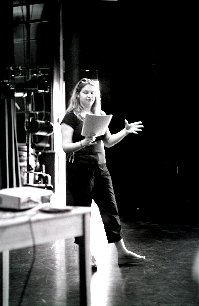
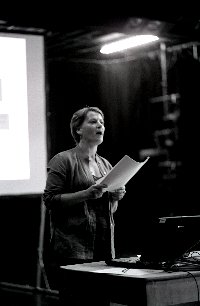
This material was presented live at the Virtuosity and Performance Mastery symposium for postgraduate/research degree students and academic staff over two days by Performing Arts at Middlesex University on 31st May and 1st June 2003.
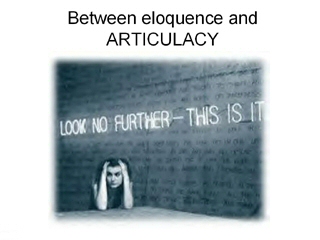
My research focuses on how we articulate the experience of performance through writing. This paper reflects on two interviews I have undertaken recently, one with Tim Etchells of Forced Entertainment, and the other with Wayne McGregor, choreographer of Random Dance. The process of constructing, conducting and transcribing these interviews, and then translating, editing and reconstructing them for publication offered me some insights into the relationship between creative practice, reflective, interactive speech, and writing.
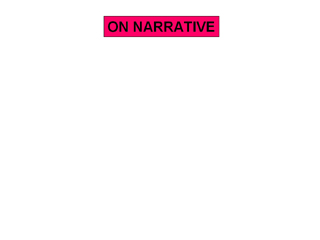
I titled my interview with Tim, On Narrative. In its published form, the interview proper was preceded by a page or so by way of introduction. This paragraph from the introduction basically functions as a précis of what I considered to be the major points of the interview:
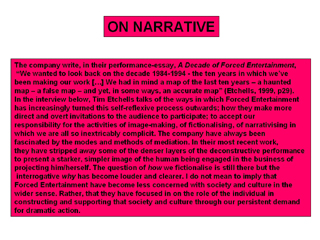
The company write, in their performance-essay, A Decade of Forced Entertainment, "We wanted to look back on the decade 1984-1994 - the ten years in which we've been making our work […] We had in mind a map of the last ten years - a haunted map - a false map - and yet, in some ways, an accurate map" (Etchells, 1999, p29). In the interview below, Tim Etchells talks of the ways in which Forced Entertainment has increasingly turned this self-reflexive process outwards; how they make more direct and overt invitations to the audience to participate; to accept our responsibility for the activities of image-making, of fictionalising, of narrativising in which we are all so inextricably complicit. The company have always been fascinated by the modes and methods of mediation. In their most recent work, they have stripped away some of the denser layers of the deconstructive performance to present a starker, simpler image of the human being engaged in the business of projecting him/herself. The question of how we fictionalise is still there but the interrogative why has become louder and clearer. I do not mean to imply that Forced Entertainment have become less concerned with society and culture in the wider sense. Rather, that they have focused in on the role of the individual in constructing and supporting that society and culture through our persistent demand for dramatic action.
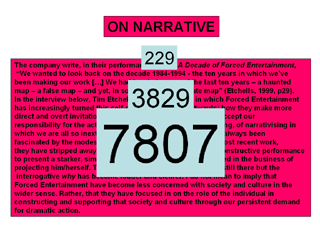
These 229 words summarise the 3829 words which constitute the published interview, which were in turn drawn from the 7807 words of my transcription.
In typing up that transcription from the tape I had made, I had of course already edited out some of Tim's other verbal articulations - 'ums' and 'ers' and grunts and laughs as well as all of his non-verbal communications - smiles, frowns, gestures. I had also, of necessity, added words of my own in order to fill in the gaps left by those sentences Tim had failed to finish, and to replace all the 'likes' and 'you knows' and 'kind ofs'.
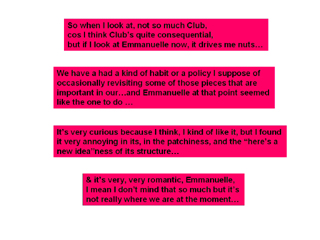
The obvious point here is that the published text constitutes a reduction - on a fairly major scale - of the original interview-event. It is also, of course, a restructuring of that event, a cut and paste job aimed at giving coherent shape to what was, in fact, a pretty random and chaotic conversation. While typing up the transcription, I was initially struck by just how inarticulate a lot of it was: not only in terms of the gaps and elisions, but also in terms of structure; how both Tim and I rambled, jumped, slipped, spun, backtracked and changed our minds mid-sentence. Sitting at my laptop, I found it very difficult to make sense out of what we had said. Yet that wasn't how it felt at the time. On the contrary, then I was excited by what had felt like a very fluent discussion, a highly eloquent expression, on Tim's part, of the way he thinks and works.
This got me thinking about the difference between eloquence and articulacy. The conversations I had had with these two practitioners about their work had some elements in common: Although I had planned to ask specific questions, it was impossible for me to follow my preconceived structure. Sometimes Tim and Wayne would begin to answer my question but then some internal association or memory would carry them off in a different direction. At other times, they started their response at what initially seemed like an entirely unrelated point but then spiralled back in to the question. Their explanations of their creative processes were anecdotal, drawing on areas of their lives that lay outside the boundaries of their performance work. At times, I got the distinct impression that they weren't talking to me at all, but to some other, possibly generic academic or critic or spectator.
The overall effect was of something multi-layered and extremely complex; sometimes difficult to follow, but not illogical. On the contrary, at the time of the conversation it felt like looking at the perfect London Transport map, where train lines, tube lines and bus routes are all laid over one another on a real road map so that you can see both directions and connections. I felt as if I had been carried inside their creative working processes, where life is work and work is life and everything is continually moving and changing, where questions are continually re-posed but never answered, though they may be stowed away for a while, where everything functions simultaneously and interactively and sometimes randomly, and most importantly, where where you are and who you're with and what you're doing work in constant dialogue with your mind.
Of course, that's too simplistic. There are all sorts of factors which work against such easy transparency, but nonetheless, we feel it is worth exploring the ways in which interactive speech might offer access to creative processes at a point before writing
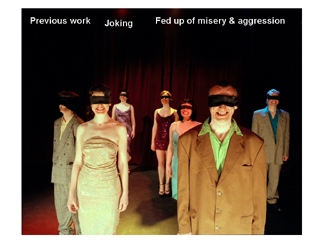
Example 1
I asked Tim about the starting point for the show, First Night:
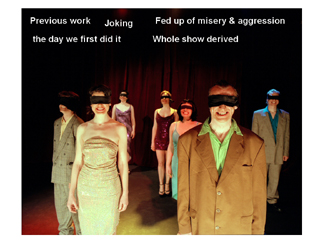
MARIANNE (reading Tim's words): "I think FN came largely for me
from reaction to a couple of previous pieces where I was joking in a way but I said I want
everybody to smile because I'm fed up of us looking miserable and being aggressive but,
the smiling part came forward. The beginning was really the smiles and I knew that I wanted
them to smile all the time."
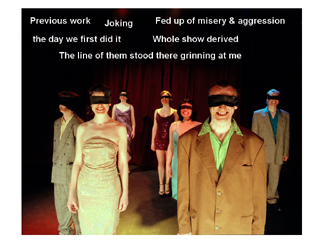 "The day that we first did it I was completely addicted to the way they looked…we
derived the make up and everything that they looked like from the smiling and then the whole
show derived itself from the smiling. We didn't know what they would do, what they would
talk about, what it was, even."
"The day that we first did it I was completely addicted to the way they looked…we
derived the make up and everything that they looked like from the smiling and then the whole
show derived itself from the smiling. We didn't know what they would do, what they would
talk about, what it was, even."
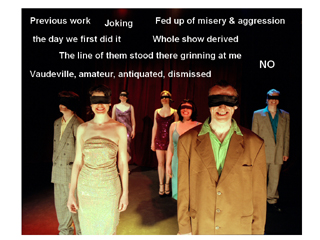 "I
just knew that I liked the line of them stood there grinning at me, that I sat there smiling
too…"
"I
just knew that I liked the line of them stood there grinning at me, that I sat there smiling
too…"
JACKIE: So it wasn't like a particular interest in that kind of cabaret…
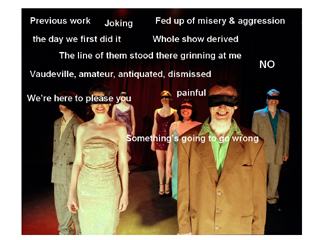
MARIANNE (reading Tim's words): "No, I mean there's always been an interest from us in any kind of vaudeville or amateur or antiquated or dismissed kinds of performance. The references in our work are usually to those kinds of things rather than to theatre because I don't think we know anything about theatre in that sense. But it is, in a way, that other stuff is the stuff that we trade in so yeah in a way it was part of that but more than anything it was wanting the smiles and wanting that kind of 'we're here to please you', but obviously as soon as you smile like that it looks painful and it looks like something's going to go wrong."
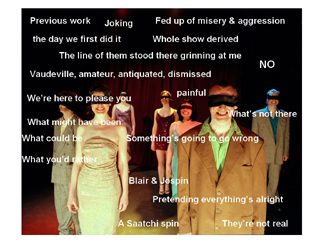
JACKIE: With the kind of stories in FN, a lot of it seemed to be about refusing to give us any stories…
MARIANNE (reading Tim's words): "Well I think FN's very much about what's not there and it's very much about creating blank spaces where you're forced to imagine what might have been there otherwise or what could be there or perhaps what you would rather were there than that. In a way, I can't think about FN except in the context of Tony Blair and Jospin and all these kind of neo-liberal politicians. It is the same thing. It's smiling and pretending that everything's alright and that we're all together when we're not & it isn't and the more they put that, really a Thatcherite, kind of Saatchi spin on their persona, their presence, the worse it is, the more you just think 'they're not real'."
Here, Tim is remembering the way an idea occurred and then developed through the process of rehearsal. He has a strong visual memory of the point when the idea emerged because it emerged from a visual event. In talking about that moment, he remembers all the other elements of his thinking at the time which were woven into his first response to the smiling, or got layered over it as time went on. What seems relatively simple is actually very complex. In fact, in rehearsal, it all probably went more like this:
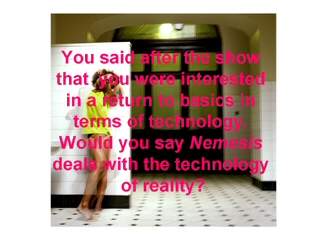 Example 2
Example 2
My interview with Wayne McGregor offers a second example of the practitioner undertaking a retrospective journey to the point where an idea began. As a dancer, Wayne thinks kinetically.
MARIANNE (reading Wayne McGregor's words): "It was this idea of a minimal technology. It was the idea of a memory, but a memory of a space you can't quite locate. One location was a naval officers' college in Piccadilly. What interested me about it was that it was this huge, very ornate, very beautiful building with very palatial rooms inside, but underneath were all these little warrens and corridors which used to be the brothels of Soho. So these naval officers used to go in and disappear and do their business down there and come out looking all…again. I love that dichotomy of spaces, this very ornate, almost baroque looking space, and I wanted to do that photographically. The original idea was that, that we would have a very 2-dimensional, flat, very simple photographic element which was treated slightly differently to give you a reference of a memory of a space. You could connect, kind of abstractly, the space with the idea of the performance and there would be an association with that, and that would go through to a much more kind of 3-dimensional, or not really 3-dimensional but a bit more active and kinetic stuff, which is the film stuff which uses kind of CCTV footage of the same spaces intercut with the underneath spaces. The more kinetic moving images actually have a different feel, more kind of surveillance, more reality, so again, the idea of the photograph, of photo-realism in a way…"
One of the things I understood from Wayne's answer was that he was simultaneously inhabiting several different spaces and time zones at once. The space-time environment of the interview is multiple and simultaneous rather than linear and chronological. I also asked Wayne about a notion I'd had about his show, Nemesis, that the piece was concerned with excavating moments, digging into them to find more dimensions of time and space than we can normally see or experience. His verbatim answer lasts, on paper, for just over a page.
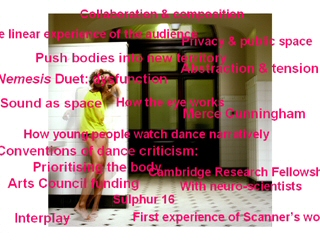 Example 3
Example 3
MARIANNE (reading Wayne McGregor's words, trying to keep up with the key phrases appearing on the ppt): "It's how you correlate choreographic space with emotional space or time space and how you connect the two.
"What I'm interested in when I'm working with the collaborators is that we have then all those individual languages, and my job as a choreographer, I think is the composition of them. So you start …
"Because time is a literal concept, it starts here and ends over there, when you're sat in a theatre watching from here to here … there is a linear production to that …
"Oh yes, Sulphur 16, the idea was that certain sections felt interminable, almost like 20 minutes and you want it to be over, and another section of the same length would feel like 5 seconds….
"But if you move very, very, very quickly for a long period of time, eventually your eye stills and actually you see slow movement…
"I'm working with 5 neuro-scientists on this specific thing - how can I work collaboratively but not verbally? Because there's always been a frustration for me of always having to articulate my ideas verbally 1st…
"Well, the thing about the Arts Council is trying to find different formats for applications because I don't think that a written application is always the best way of demonstrating…
"Young people, they're so bound in this narrative understanding of stuff, they find it difficult to watch things that aren't literally-oriented.
"The reason I work with Scanner, what interests me about him is that he does things like sound violations. I met him at the South Bank, he was doing this concert there that he nearly got arrested for, where basically he was sampling mobile phone conversations live and playing them out and just distorting them so you had a very personal, intimate conversation on a mobile that would be made public and…
"It's almost like a kind of spatial concept but in sound.
"Something in the sensibility of it, the difficulty of it or the tension in it that gives you a really fantastic sound world …
"So that duet for example which is a very intimate conversation about a break-up, near the beginning and there's a longer version after the 1st section with Ben and Laila…
"I build a duet in that case around something that's really physically dysfunctional …
"…and it's the combination of all those things that allows us to have those kind of interplays because in a way they've all got their own literacy and it's for the audience to build the connections.
"Dance critics always make the body a priority.
"I mean that the body isn't just the body as in arms and legs, but also it's how you push the body until you describe new territory…
"Merce Cunningham said to me, one of the hardest things to do in life is unlearn things. I thought that was really interesting - to unlearn is harder than to learn… it just really stuck with me…"
We can grasp here the multiple interactions between Wayne's various different life-roles as choreographer/composer, researcher, Arts Council Board member, teacher, spectator/listener at Scanner's concert, subject of theoretical writing and pupil of Merce Cunningham. We can understand how ideas addressed in one project, Sulphur 16, are revisited in another, Nemesis, and also where those ideas are taking him now, into his research project with the Cambridge neuro-scientists. It is simultaneously apparent that this research project links back to much earlier frustrations and inspirations, ghosts of past experiences that appear like the transparent projections he so often incorporates into his work. This whole section of the interview is in fact an excellent metaphorical illustration of precisely the point at which this part of the conversation began - the excavation of a moment to reveal its densely complex hidden dimensions.
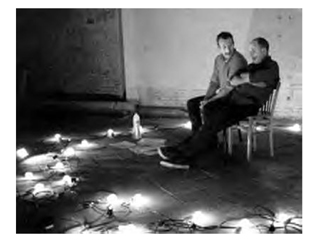
While there are clearly subjects in an interview that practitioners have thought-through, spoken about or even written about before, there is often also a sense that their own understanding of where something in their work has come from or how it operates is evolving as they speak to you. In my interview with Tim Etchells, we had been speaking about endings, how audiences tend to want them and how Forced Entertainment refuses to give them:
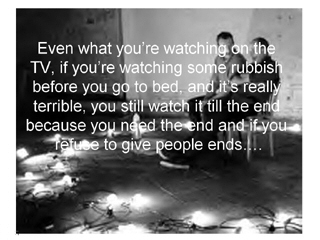
Example 4
MARIANNE (reading Tim Etchell's words): "One of the stories in Instructions for Forgetting, part of that's about the time that we first took Miles to the cinema. We took him to see James and the Giant Peach when he was about 3, 3 and a half, too early, and he was very, very scared, so scared that he was basically freaked out and he wanted to leave. He was scared at the moment in the film where the actor, the child actor is transformed into a kind of digital animation, so you lose the real actor and you get this stick figure. He kept saying, 'When will James come real again?' He was very frightened of that. He really wanted to go. The decision, the feeling was, we should stay because we know it's going to have a happy ending and my feeling was, which is in the performance, I say, that he should stay because if he doesn't stay this story might hang there for ever unfinished & unresolved and unsolved and like this kind of incomplete problem & so we stayed and it's all fine in the end so it has this, like in a way, the comfort that closure brings. & it seems to me, in that context, to be absolutely no coincidence then that And on the 1000th Night absolutely refuses to give you that. It's about nothing ever, ever, ever finishing, everything's being swallowed by every previous thing. I think it's a very generous performance, but also in a funny way, when I think about it like that, there's no solace in it…"
There is an uncertainty here, in that phrase "when I think about it like that", in the fact that, in responding to my question about endings, Tim immediately turned to his experience as a parent, a role in which few people feel sure about what they think or feel or do. This was unsettling, but eloquent in its illustration of the contradictions and tensions which fuel so much of Forced Entertainment's work.
What we've attempted to highlight is what interactive speech can offer by way of insight into the eloquence of the practitioner. The task of the academic interviewer is to translate that into writing, to go through a specific process of articulation which includes editing, restructuring, linking disparate elements together and filling in gaps with the aim of producing a kind of narrative direction, order and coherence. Is there something that we lose by doing this?
MARIANNE (reading Wayne McGregor's words): "It worked both ways really. Since that film I've reworked the language of the 2nd half. Obviously I know the body much better than I know the body with these arms and I just felt that it was a bit dimensionless in a way. I've really worked the material now. It's much more suitable for our understanding of those, we've learnt much more about them and what their capabilities are.
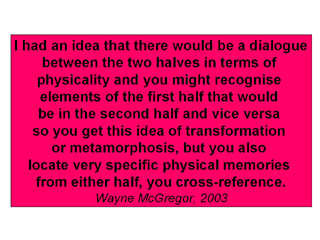 "So originally I had an idea that there would be a dialogue between the two halves
in terms of physicality and you might recognise elements of the 1st half that would be in the
2nd half and vice versa so you get this idea of transformation or metamorphosis, but you also
locate very specific physical memories from either half, you cross-reference basically. So I
tried to keep that dialogue but I tried to push the language of the arms on a much more
extreme way now we've become more comfortable with them so it's more dangerous. The
dancers would always be cautious in case they hurt someone but as they went through the shows
they've gained confidence with where the ends of their fingers were and where the end of
their limb was and we could be much more dangerous with the possibility of it. But at the end
of the day it was an experiment and although it was interesting it is not something I can
ever develop, the prosthetic thing. It is quite limiting, because unless you have a massive
articulation of those arms, they become such a feature. But it was interesting how it shifts
your idea of where your pelvis is, your pelvis is in a completely different place, you get a
sense that these arms are the same length as your legs, you've got a completely different
geometry. And that geometry is very interesting in terms of the architectural spaces that
we're using anyway…"
"So originally I had an idea that there would be a dialogue between the two halves
in terms of physicality and you might recognise elements of the 1st half that would be in the
2nd half and vice versa so you get this idea of transformation or metamorphosis, but you also
locate very specific physical memories from either half, you cross-reference basically. So I
tried to keep that dialogue but I tried to push the language of the arms on a much more
extreme way now we've become more comfortable with them so it's more dangerous. The
dancers would always be cautious in case they hurt someone but as they went through the shows
they've gained confidence with where the ends of their fingers were and where the end of
their limb was and we could be much more dangerous with the possibility of it. But at the end
of the day it was an experiment and although it was interesting it is not something I can
ever develop, the prosthetic thing. It is quite limiting, because unless you have a massive
articulation of those arms, they become such a feature. But it was interesting how it shifts
your idea of where your pelvis is, your pelvis is in a completely different place, you get a
sense that these arms are the same length as your legs, you've got a completely different
geometry. And that geometry is very interesting in terms of the architectural spaces that
we're using anyway…"
Jackie Smart is a Senior Lecturer in Drama at King Alfred's College, Winchester. Her research concerns the relationships between performance practice and analysis. She also writes, directs and performs with her company, Quisling.
Marianne Sharp is Lecturer in Drama at King Alfred's College, Winchester. Her research concerns performer-knowledge. She continues to perform and direct professionally, most recently in her original devised production, Juliet's Dream.
Web design and monochrome pictures copyright © John Robinson 2003-2004.
All other images (including background image) are copyright © Forced Entertainment/Hugo Glendinning.
Page last updated 30th August 2004.